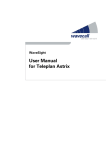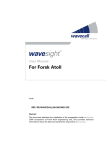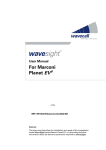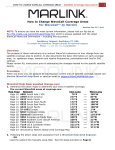Download Company Information
Transcript
User Manual For Optimi Wizard <V 2.5> WaveSight - User Manual for Wizard Company Information Address Lausanne Wavecall SA Science Park of the Swiss Institute of Technology PSE-B / EPFL 1015 Lausanne Phone +41 21 693 84 05 Fax +41 21 693 84 06 Contact Odeh Ghawi Email Web [email protected] http://www.wavecall.com Document History Version Revision Date 1.0 HOUSSAM ABED NOVEMBER 18,2002 2.0 ODEH GHAWI JANUARY 22,2003 2.2 ODEH GHAWI MAY 08,2003 2.3 ODEH GHAWI FEBRUARY 05,2004 2.4 JÜRGEN EITLE JUNE 3, 2.5 JÜRGEN EITLE JUNE 15, 2004 Confidential Wavecall SA 2004 Jun-04 - Page 2/2 WaveSight - User Manual for Wizard Contents Company Information..................................................................................................................................... 2 Document History .................................................................................................................................. 2 1. Introduction ........................................................................................................................................ 4 2. Installation and configuration ............................................................................................................... 5 2.1 Version........................................................................................................................................... 5 2.2 Prerequisites.................................................................................................................................... 5 2.3 . Installation procedure..................................................................................................................... 5 2.4 . Installation files ............................................................................................................................. 6 2.5 WaveSight Parameters ..................................................................................................................... 7 2.5.1 General WaveSight Parameter: .................................................................................................. 7 2.5.2 Advanced WaveSight parameters............................................................................................... 8 2.5.3 Clutter Parameters .................................................................................................................... 8 2.6 3. Assign WaveSight Propagation Parameters to Transmitters: ................................................................ 9 WaveSight ray tracing model ............................................................................................................. 12 3.1 Background................................................................................................................................... 12 3.2 WaveSight feature overview ........................................................................................................... 12 3.3 Accuracy ............................................................................................................................................ 12 3.4 4. Computing time............................................................................................................................. 13 Appendix I........................................................................................................................................ 14 (WaveSight error messages) ...................................................................................................................... 14 6. Appendix II ...................................................................................................................................... 16 (WaveSight warning messages) ................................................................................................................. 16 7. Bibliography..................................................................................................................................... 17 Confidential Wavecall SA Jun-04 - Page 3/3 WaveSight - User Manual for Wizard 1. Introduction WaveSight is a highly accurate wave propagation prediction tool for wireless networks. It is specifically used to predict radio wave propagation for mobile communication networks in urban environments. The deployment of a cellular network is subject to very tight schedules that must ensure high quality service. WaveSight is instrumental in reducing costs and planning time, and in improving network quality as it meets prediction accuracy requirements. To achieve high prediction accuracy WaveSight uses new methods of calculation that were validated as part of thesis research conducted at the Swiss Institute of Technology in Lausanne (EPFL), Swisscom in Bern, Switzerland, Dutch Telecom (KPN) in the Hague, the Netherlands and at Bell Laboratories of Lucent Technologies, Crawford Hill, New Jersey. The inputs for WaveSight 3.6.1.7 are: 1) Buildings, vegetation (in case available) described as vectors Note that in the current integration in Wizard the vegetation cannot be taken into account. 2) Terrain given in raster format. 3) Clutter given in raster format. 4) Transmitter parameters, Antenna pattern, antenna height, direction, tilt, power (EiRP dBm), frequency. 5) Receiver parameter, WaveSight use receiver height only. Confidential Wavecall SA Jun-04 - Page 4/4 WaveSight - User Manual for Wizard 2. Installation and configuration 2.1 Version Component Version information WaveSight 3.6.1.7. Interface 1.0.0.8 2.2 Prerequisites WaveSight requires the following environment: 1. Wizard on Windows Platform, version 6.5 or later version. 2. Minimal hardware requirements: 128MB of RAM, 200MB of disk storage 2.3 . Installation procedure Important: 1. Before installing the new version of WaveSight any existing model that has a previous link to WaveSight should be deleted, the mentioned model could be deleted as following: from the Files menu select Delete, select the Global option then from the drop list select “Propagation Parameters File” and delete the old model. (Figure 1) To install WaveSight to Wizard, you unzip the “WS4WZ6.5.1V1.0.0.8.zip” file to a temporary directory and run the setup.exe program. In the following sections we will assume that Wizard is installed in the directory "“%INSTALLDIR%". The installation setup will put WaveSight into the “%INSTALLDIR%\bin” directory. Confidential Wavecall SA Jun-04 - Page 5/5 WaveSight - User Manual for Wizard Figure 1 Delete the old model with a link to a previous WaveSight installation 2.4 . Installation files To check if WaveSight has been installed correctly, the following paragraph is giving a brief overview over the installed WaveSight files: The WaveSight files are installed in the directory “Bin\wavesight” under the same installation directory of Optimi Wizard. The installation program does the following additions to the Wizard installation: Confidential - Copies WaveProp.exe to %INSTALLDIR%\Bin - Create the folder "WaveSight" in the folder "%INSTALLDIR%\Bin". - Copy the files "wavesight.exe", “Grid2Trn.exe”, "All2Grid.exe", "WaveSight_Dependency.XML", "WaveSight GSM Template.xml", and WsModel.dll to the directory "%INSTALLATIONDIR%\Bin\wavesight". - Creates the folder “ModelData” in the %INSTALLDIR%\bin\WaveSight directory - Copies the file “WaveSight GSM %INSTALLDIR%\bin\WaveSight\ModelData - Copies the files “mfc70.dll” and “msvcr70.dll” to the %systemroot%\system32 directory - Registers the WsModel.dll - adds some keys into the registry. Wavecall SA Parameters.xml” to the folder Jun-04 - Page 6/6 WaveSight - User Manual for Wizard To uninstall WaveSight for Wizard, simply run the setup.exe program again. It undoes all the steps mentioned above. 2.5 WaveSight Parameters To set-up a new WaveSight model the following step should be followed: From the menu "Edit -> Parameters -> Propagation" then select WaveSight model under Wavecall, give the model a new name. (Figure 2). Figure 2 WaveSight Propagation Parameters Menu A window entitled "Propagation Parameters" opens. The parameters that should be set for WaveSight are: 2.5.1 General WaveSight Parameter: • Building height relative to ground or to sea level: WaveSight could handle both value. • Computation Type, the area of computation: only for indoor area, only for outdoor area or both. • Indoor Attenuation: represents the penetration loss from outdoor to indoor. It is a real value and should be in dB. Confidential Wavecall SA Jun-04 - Page 7/7 WaveSight - User Manual for Wizard • Transmitter Frequency: represents the transmitters frequency in MHz. It is a real value. Default value is 900 MHz. • Receiver height above ground: Represents the receiver height above ground in meters. It is a real value and should be in meters. In WaveSight you could set this value at any height desired. • Resolution For the Computation of the Result: represents the bin size for the computation over the coverage area associated to its cells. Default value is 5.00 m. 2.5.2 Advanced WaveSight parameters a) Correction factor vertical [db]: WaveSight translates this factor to a medium loss using the following formula: o medium loss = 10-corr. factor vertical/10. the medium loss represents an attenuation associated with a ray propagating in the vertical plane over buildings. this attenuation acts as the real part of the wave number. the higher the real part of the wave number the higher is the medium loss. therefore according to the equation above the smaller the corr. factor vertical the higher is the medium loss. this factor can be used to account for loss due to objects not represented in or missing from the geographical database. b) Correction factor horizontal [db]: wavesight translates this factor to a medium loss using the following formula: o medium loss = 10-corr. factor horizontal/10 the medium loss represents an attenuation associated with a ray propagating in the horizontal plane around buildings. this attenuation acts as the real part of the wave number. the higher the real part of the wave number the higher is the medium loss. therefore according to the equation above the smaller the corr. factor horizontal the higher is the medium loss. this factor can be used to account for loss due to objects not represented in or missing from the geographical database. c) Correction factor terrain [db]: wavesight translates this factor to a medium loss using the following formula: o medium loss = 10-corr. factor terrain/10. the medium loss represents an attenuation associated with a ray propagating in the vertical plane after diffraction from terrain (typically in open areas). This factor is only taken into account if there is no clutter associated with the point of diffraction. This attenuation acts as the real part of the wave number. the higher the real part of the wave number the higher is the medium loss. therefore according to the equation above the smaller the corr. factor terrain the higher is the medium loss. this factor can be used to account for terrain occupation when no clutter values are available. 2.5.3 Clutter Parameters In order to activate the use of the clutter in WaveSight model you need to select “Yes” for the option User Clutter, for each clutter class the user must assign three values for three parameter of the clutter: Confidential Wavecall SA Jun-04 - Page 8/8 WaveSight - User Manual for Wizard Permittivity: Is the relative permittivity assigned to the clutter. The Permittivity is taken into account in the diffraction formula over the terrain. The higher the Permittivity is the more energy is diffracted from the terrain Conductivity [S/m]: Is the conductivity assigned to the clutter. The Conductivity is taken into account in the diffraction formula over the terrain. The higher the Conductivity is the more energy is diffracted from the terrain Correction Factor [dB]: represents attenuation associated with a ray propagating in the vertical plane in open area above certain clutter 2.6 Assign WaveSight Propagation Parameters to Transmitters: To assign WaveSight Propagation Parameters to a transmitter, there are two ways to do so: 1. At the cell level, the process is done as follows: Open the transmitter parameters editing window (Figure 3) Click on the "View" button in the "Propagation Parameters" section. A new window appears asking to choose the Propagation Parameter File (Figure 2). Choose the WaveSight model created previously as it has been described in paragraph 2.5 and select it. 2. At the project level, the process is done as follows: From the Edit menu select the option Project…->RF Parameters-> under Propagation Parameters select one of WaveSight model, previously created as it has been described in paragraph 2.5. (Figure 4). Confidential Wavecall SA Jun-04 - Page 9/9 WaveSight - User Manual for Wizard FIGURE 3 BTS DATA WINDOWS Confidential Wavecall SA Jun-04 - Page 10/10 WaveSight - User Manual for Wizard Figure 4 Selecting WaveSight at the project level. Assignment of other transmitter parameters goes as described for Wizard. The parameters that WaveSight uses from Wizard transmitter properties are: - Easting - Northing - Elevation - Antenna Type - Azimuth - Tilt - ERP - Calculation Distance for the frame area of calculation. 3. After finishing transmitter parameter assignment, Choose from the menu "Analyze" the command "GSM Coverage" The Process of calculation goes as usual. WaveSight uses the Terrain file and the Building file assigned to the Wizard project. Confidential Wavecall SA Jun-04 - Page 11/11 WaveSight - User Manual for Wizard 3. WaveSight ray tracing model 3.1 Background WaveSight is the result of more than eight years of research and development. The foundations of WaveSight are inspired from a five years Ph.D. thesis fully sponsored by well-established industrials in the domain of telecommunication such as Swisscom, KPN and Lucent technology. A strong team of renowned researchers continue working on extending the range of applicability of the model and increasing its performance. Wavecall research team has published more than 50 technical papers in the domain of propagation and can be considered as a world leading think tank in radio wave propagation. 3.2 WaveSight feature overview WaveSight uses a combination of deterministic ray tracing in the vertical plane and the horizontal plane. Based on the uniform theory of diffraction (UTD) and ray-tracing, its algorithms take individual building foot prints and heights, as well as the terrain profile into account and accurately predict the signal power at every point of the area covered. Its innovative implementation permits for unprecedented computing efficiency. The algorithm enables the simulation of a micro cell with a computation time of around 1 minute and a macro cell with a computation time around 5 minutes on a Pentium II 300 MHz machine. Speed and accuracy are thus no longer contradictory. Because the method is fully deterministic, there is no need for calibration or measurement on the field. The domains of application include Wireless mobile, UMTS, Wireless Internet and fixed Wireless It applies to urban areas for any transmitter and receiver height. 3.3 Accuracy As it is impossible to obtain a sufficiently detailed description of the propagation environment to solve the electromagnetic problem in a rigorous manner, i. e. solve Maxwell's equations, so some assumptions had to be made in WaveSight to compute the propagation path loss. Even if the detailed description were available, the computation time needed to obtain a rigorous solution would be a limiting obstacle. In the absence of such a rigorous solution, the only way to test the validity of the WaveSight model is the comparison with measurements. Therefore validations against measurement are a fundamental component of the model. Wavecall performed a large number of validations of WaveSight against measurements. The validations included comparisons over 1000 km of measurement routes in 100 cells located in a dozen of European and American cities. These comparisons showed that the WaveSight model achieves increased prediction accuracy in comparison with the classical models. Confidential Wavecall SA Jun-04 - Page 12/12 WaveSight - User Manual for Wizard 3.4 Computing time WaveSight uses one of the most comprehensive methods to compute the propagation, that is ray tracing. This method is well known not only for its superior accuracy but also for being computing time demanding. The ray tracing implementation in WaveSight are innovative and original. They make use of numerous geometrical and electromagnetic tricks to minimize the computing time. Figure 14 shows an example of the calculation time with relation to the area of study. Note that the calculation time for the area of 8X8km, with a resolution of 5m is very high. This is because the machine RAM is low, in this case WaveSight is swapping, i.e. using the hard disk as memory, which make the computation time very slow. It is highly recommended to use 512 Mbytes of RAM when the studied area is more than 4x4 km. TEST FOR THE CALCULATION TIME OF WAVESIGHT VERSION 2.2.17 MACHINE: PENTIUM III, 650 MHZ RAM: 196 MB CITY: TORINO ANTENNA: ISOTROPIC FREQUENCY 1890 MHZ RECEIVER HEIGHT: 1.5M AREA OF STUDY 1X1 KM 2X2 KM 4X4 KM 8X8 KM RESOLUTION CALCULATION CALCULATION CALCULATION CALCULATION TIME TIME TIME TIME 5 1 MIN 12 S 4 MIN 57 S 16 MIN 15 S 104 MIN 15 S 10 1 MIN 4 S 4 MIN 21 S 13 MIN 50 S 24 MIN 49 S 20 1 MIN 2 S 4 MIN 14 S 13 MIN 10 S 21 MIN 20 S Figure 14 WaveSight computing time with relation to the area of study. Confidential Wavecall SA Jun-04 - Page 13/13 WaveSight - User Manual for Wizard 4. Appendix I (WaveSight error messages) Errors Explanations WSERR1: You cannot have an IndexTerrDir and a TerrainFile. Please check infiles.txt IndexTerrDir is a key word in infiles.txt that indicates the directory of a specific type of terrain format. TerrainFile is a key word in infiles.txt that indicates the path for the file WaveSight type of terrain. Therefore it is not possible to have both keywords in infiles.txt WSERR2: You cannot have an IndexBldgDir and a BldgFile. Please check the inputs.txt file IndexBldgDir is a key word in infiles.txt that indicates the directory of specific type of building format. BldgFile is a key word in infiles.txt that indicates the path for the file WaveSight format of buildings. Therefore it is not possible to have both keywords in infiles.txt WSERR3: hori directory not found In the WaveSight directory a sub directory named hori must exist. On PC platform this directory is created automatically On UNIX platform this directory must be created manually WSERR4: Insufficient memory WSERR5: This handle full 3D version cannot The CompType in comp.txt is set to 2. WSERR6: The antenna pattern is given with a resolution higher than half degree WSERR7: The pattern of the specified antenna is not listed in the antenna file The file which contains all antenna patterns, (it is specified via the keyword AntFile in infiles.txt) does not contain the antenna pattern specified in transmitter WSERR8: An antenna file name must be provided The AntPtrn key word in the transmitter file indicates a pattern, but infiles.txt does not contain the path to the file where this pattern can be found WSERR9: Buildings elevation is relative to ground and there is no terrain file Confidential WSERR10: No frame file is given It is mandatory to indicate in the infiles.txt a frame file with the key word FrameFile WSERR11: Error in frame file: east x >= west x The frame file indicated by the key word FrameFile in infiles.txt, must contains the x of the south east corner the y of the south east Wavecall SA Jun-04 - Page 14/14 WaveSight - User Manual for Wizard the south east corner, the y of the south east corner, then the x of north west, and then the y of the north west corner. Confidential WSERR12: Error in frame file: south y >= north y The frame file indicated by the key word FrmFile in infiles.txt, must contain the x of southeast corner, the y of the southeast corner, then the x of northwest, and then the y of the northwest corner. WSERR13: Error in the index file: east x >= west x The index file of terrain heights of specific format indicated by the key word IndexTerrDir, must contain the x of south east corner, the y of the south east corner, then the x of north west, and then the y of the north west corner WSERR14: Error in the index file: south y >= upper y The index file of terrain heights of specific format indicated by the key word IndexTerrDir, must contain the x of south east corner, the y of the south east corner, then the x of north west, and then the y of the north west corner WSERR15: No index directory for terrain is given The index file of terrain heights of specific format indicated by the key word IndexTerrDir must be given in infiles.txt. Buildings are by default assumed to be given relative to ground level, except if the flag Is2Ground is set to 1 in comp.txt WSERR16: This version can only handle Profile or Horizontal propagation In comp.txt CompType was set to a value different from 1 (horizontal computation) or 3 (combination of vertical and horizontal plane computation) WSERR17: No Tx file is given For propagation prediction a transmitter file must be given in infiles.txt using the key word TxFile WSERR18: No index directory for buildings is given When running with a specific type of buildings, the directory that contains the index.txt file must be given in infiles.txt via the key word IndexBldgDir WSERR19: Null sized segment: ... It indicates that a null sized segment was encountered in the course of the execution. For instance, this message occurs when reading the building files and a null sized wall exists in the building file. Wavecall SA Jun-04 - Page 15/15 WaveSight - User Manual for Wizard 6. Appendix II (WaveSight warning messages) Warning Action needed WARNG: data base error, see mapcheck.txt ERROR IN BUILDINGS DATABASE, THIS ERROR COULD CAUSE BAD PREDICTION ON THE LINE BETWEEN THE TRANSMITTER AND THE ERROR. THE CAUSES OF THIS ERROR ARE LISTED ABOVE IN THE BUILDINGS DATA SPECIFICATIONS. The action needed is to correct the error listed in the file mapcheck.txt WSERR2: Removed xxx buildings THIS MESSAGE DOESN'T SHOW ANY ERROR, BUT THE NUMBER OF BUILDINGS THAT BECAUSE THEY HORIZONTAL WERE WAVESIGHT NOT CALCULATIONS, A PART SINCE REMOVED OF THE THEY ARE COVERED BY OTHER BUILDINGS. No action needed for this warning. WSERR3: Assertion failed Confidential Error in buildings database, The causes of this error are listed above in the buildings data specifications. Wavecall SA Jun-04 - Page 16/16 WaveSight - User Manual for Wizard 7. Bibliography [1] KARIM RIZK: PROPAGATION IN MICROCELLULAR AND SMALL CELL URBAN ENVIRONMENT, THESIS #1710 (1997), SWISS FEDERAL INSTITUTE OF TECHNOLOGY OF LAUSANNE [2] K. RIZK, J.F. WAGEN, F. GARDIOL:INFLUENCE OF DATABASE ACCURACY ON TWO-DIMENSIONAL RAY-TRACING-BASED PREDICTION IN URBAN MICROCELLS, IEEE TRANS. VEH. TECHNOL., VOL. 49, NO. 2, MARCH 2000, PP. 631-642. . Confidential Wavecall SA Jun-04 - Page 17/17





















